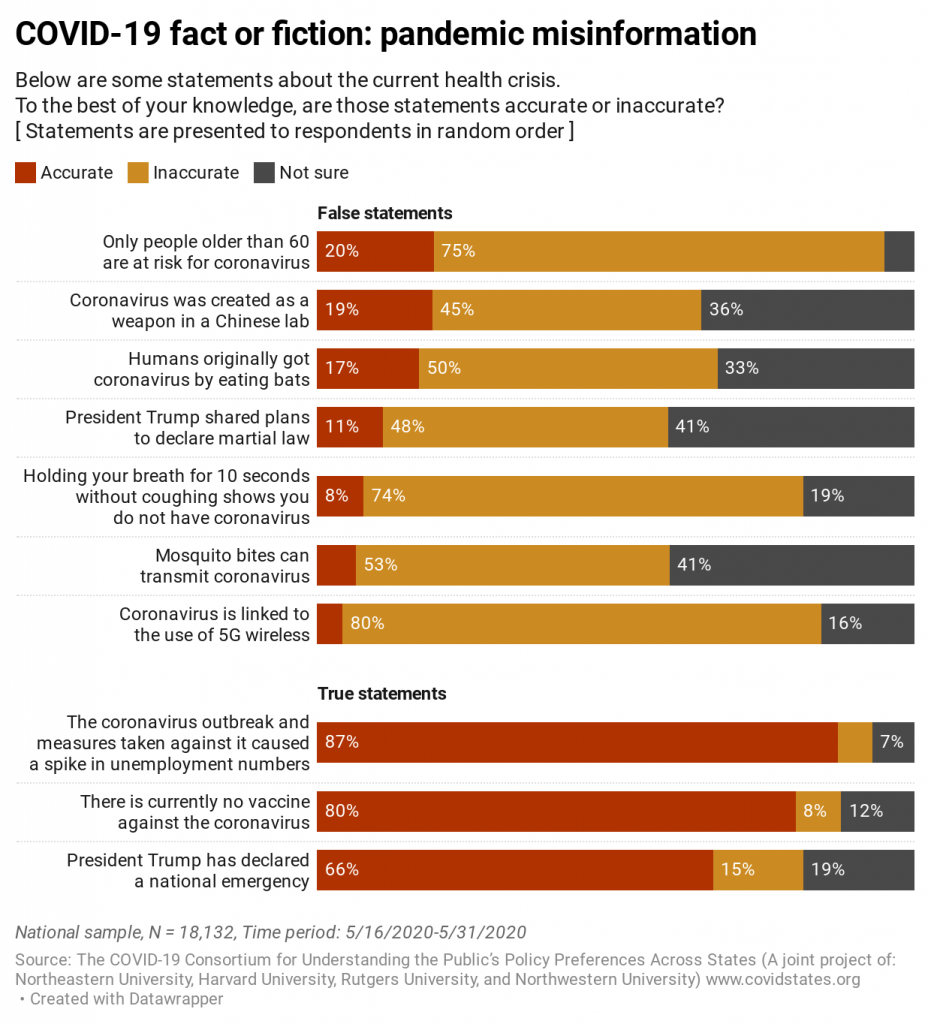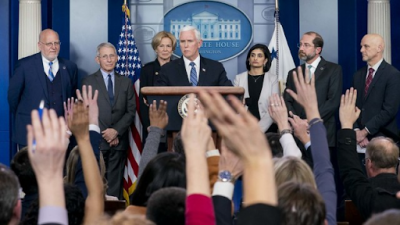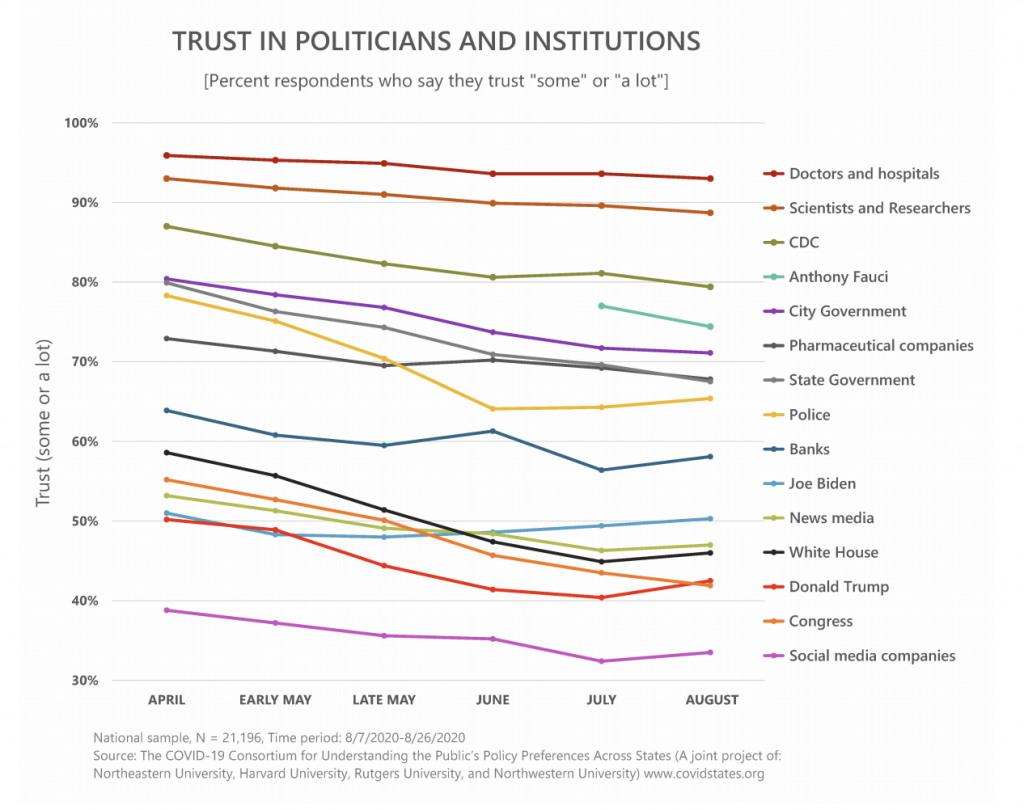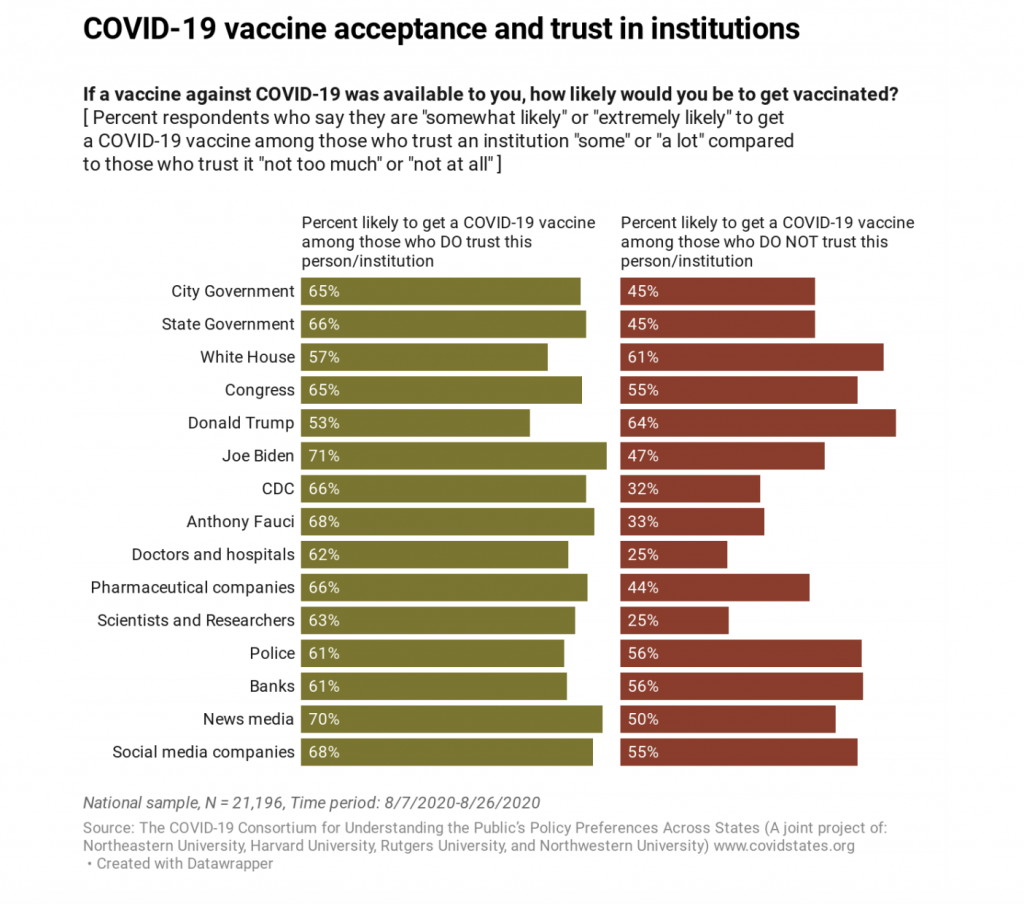8 Impact of Communication on Public Trust In Institutions During the COVID-19 Pandemic
Caroline Mace
Introduction
The COVID-19 pandemic is accompanied by a myriad of mass communication strategies, including social media, press releases, and newsletters. These strategies were made possible by rapid advances in communication technology in recent years. While smaller epidemics have occurred with this technology available, the speed and range of mass communication strategies in spreading information is much greater in 2020 than in previous pandemics. Governments, scientific communities, and corporations are able to relay salient information as quickly as possible. While our current methods of communication allow a large portion of the population to receive up-to-date information on many issues, this does not necessarily mean the general public is well informed on those issues.
Unfortunately, the ever-changing and evolving nature of COVID-19 discoveries create a significant risk of miscommunication. Whether intentional or not, false information regarding COVID-19 related safety measures, reported cases of the disease, or the Coronavirus itself spreads exponentially through the communication networks meant to keep the public informed. While the goal of mass communication is for the general public to be able to make smart and safe decisions, the circulation of rumors and speculation obscures that purpose, which can– in severe situations– contribute to the prolonging of the COVID-19 pandemic (Hopf et al.). As public anxiety surrounding the pandemic continues to grow, the communication blunders of governments and health organizations are amplified and significantly impact public trust in these institutions. Ultimately, the Coronavirus pandemic and communication surrounding it created wavering trust in government and scientific institutions throughout the United States and other affected areas in the world.
Connection to STS Theory
The impact of mass communication on the public’s perception of government, scientific and health organizations during the COVID-19 pandemic exemplifies both the Actor-Network and Social Constructivism theories. The Actor-Network theory applies to this subject because public perception during the COVID-19 is shaped by both science and society. Science and society are composed of a variety of actors, human and non-human, that impact each other. For example, policymakers rely on information from scientists and researchers on how to deal with COVID-19, and their policies during the pandemic impact the spread of the disease, which researchers will observe. Social Constructivism applies to the subject because some groups are more likely to believe in certain ideas about COVID-19 than others, and their beliefs are often unwavering despite new scientific understandings on the virus. Political, religious, and demographic characteristics will often impact an individual’s views on both the virus itself and scientific and government institutions in relation to it.
Public Health Communication
Proper communication of public health information is imperative in any situation, whether a crisis is present or not. However, the importance of accuracy, reliability, and expanse of this information is critical during high-stress times, like the Coronavirus pandemic. The goal of mass public health communication is to help individuals make informed decisions for the safety of themselves and their families, which has become increasingly complicated with the presence of COVID-19. Additionally, as the internet and social media have made the dispersal of health-related information easier, the levels of distrust in science have increased due to sensationalism. Sensationalism is the use of shocking language or “clickbait” in reporting to attract more readers in journalism. Many scientists want their research to accumulate widespread support and sensationalism is one way to gain that. Due to this the first priority of some in the scientific community may not always be the integrity of their work– which is integral to sound research.
It is important to note, however, that the scientific community is not wholly responsible for a trend of decreased confidence in science. In recent years, misinformation regarding science and health topics has been spread not only by incorrect reporting of research, but also by dismissing sound research as opinion, or something to be “believed” or not (Hopf). Politicians and corporations alike have misled constituents and consumers by invalidating information that would help them make informed decisions. Most notably, climate change (the scientifically proven phenomenon of the heating of Earth) has been made into a political debate, when in reality it is factual information (Gollust et al.). This type of misinformation has continued and adapted to the Coronavirus pandemic.
For effective and meaningful public health communication, it is important for scientific organizations, governments, and businesses to follow the common goal of collaborating in their public education and sending a consistent message. Because misinformation cannot be linked to one specific institution, it is important for all organizations ensure the material they present to the public is working toward the objective of bettering society and better equipping those who live within it (Scheufele). This specific issue, which was present before and continues during the Coronavirus pandemic, is what spreads misinformation and can lead to public distrust in institutions.

In addition to continued problems facing effective communication, new issues have also arisen, COVID-19 is creating an “infodemic”. In an effort to make the convoluted nature of the Coronavirus accessible to the general public, health organizations run the risk of oversimplifying the very complex issue and failing to recognize the many facets of the disease and how it spreads. Additionally, because research about Coronavirus is advancing rapidly and ever-changing, the definition of accurate information changes constantly as well (Scheufele). This variability makes COVID-19 difficult to understand on the individual level. Effective health protocols and mandates are also evolving, and changes to them need to be effectively communicated to the public. This problem showcases the importance of collaboration between researchers, the government, and media sources to relay and make decisions based on the most current information. Likewise, politicians and journalists must understand that criticizing inevitable miscommunications can lead to even greater levels of public distrust.
Overall, because of our rapidly evolving knowledge of COVID-19, misinformation is often unavoidable. It is even more imperative than usual to decrease the circulation of intentionally false or unproven information. Examples of such unreliable reporting include not only blatant false statements but also manipulating facts and treating not-yet-proven theories as true (Hopf). The increased importance of communication during the pandemic intensifies pressure on governments and the scientific community. Any mistakes– avoidable or not– were amplified to the public, creating an environment for public distrust.
Public Response
As public fear and polarization increased regarding the Coronavirus pandemic, missteps taken by scientific and governmental organizations did not go unnoticed. Responses to these blunders varied– but generally included both skepticism and distrust. As mentioned earlier, trust in science and scientific research was already trending down before the virus. In an effort to understand this trend and how it translates to the COVID-19 pandemic, Johns Hopkins University’s Bloomberg School of Public Health conducted a survey of over 1,400 Americans during April 2020. This was a time when acceptance of COVID-19 guidelines was high. Within that research, evidence of the social constructivist theory emerged. Individuals support for social distancing was connected to their political affiliation, religion, and previous trust in science (Barry et al.). The overarching theme of this research is that those who trusted science before the pandemic continued to do so. Those who distrusted science continued to feel the same, but overall supported COVID-19 guidelines. While this could have meant a great opportunity to gain public support for mandates and guidelines, miscommunication prevented that from happening.
Because of this general downward trend of trust in institutions, many Americans are finding it difficult to discern truthful and current information from myths about the virus. Of over 18,000 individuals surveyed regarding COVID-19 information and false assumptions, as many as 20% believed false information, and 15% thought true information was a myth (“Transparency, Communication and Trust”). These numbers are startling as they show a significant percentage of Americans unable to make smart and safe decisions for their health because they have been misinformed.
While some of this confusion originates from the malicious dissemination of myths, others simply stem from outdated information. For example, in the early months of the pandemic, the scientific community stressed the importance of sanitizing frequently touched public surfaces to decrease the spread of COVID-19. It was not yet fully aware of the benefits of wearing a mask and social distancing. Currently, although research has found the Coronavirus does not live long on surfaces, many individuals and businesses continue to prioritize this safety measure, whether because of genuine belief in its effectiveness or for better public optics. Those against mask mandates have also used the earlier information regarding the importance of wearing a mask to argue their true effectiveness.


Patterns in history, including after WWII and the 9/11 attacks show that that public trust in the government and other institutions is usually high during the outbreak or immediate aftermath of a crisis. However, this trust is often followed by a steady decline shortly after. It is imperative for countries to act on those increased levels of public trust during crises and take steps to ensure that the public can have continued trust in government and institutions over time. However, it is important to note that certain aspects of science and the government have been exempt from the decline in confidence. Globally, many countries experienced an increase in trust in government as citizens recognized the crucial role the state has in providing healthcare and financial aid during the pandemic (von Chamier, Nendirmwa, and Angell). In the United States, while public trust in the federal government has declined, opposite to the global trend, many citizens have indicated growing trust in their governments at the state and local levels, as shown in the chart below. Additionally, scientific researchers (not including government health organizations) rank among the highest trusted group while trust in the federal government and journalists is low (Kulke).

As mentioned earlier, distrust in institutions that relay information and put in place mandates for public health prevents individuals from making sound decisions regarding their own health and safety. Additionally, misinformation contributes to conditions necessary for collective disorder (known, in extreme cases, as rioting) which include; an us-versus-them mentality, present because of the polarization of the issue; a grievance, such as loss of income or health deterioration; and an oppressor, which could represent the government or health officials (Reicher). This phenomenon manifests in the Coronavirus pandemic by citizens refusing to wear masks, not following guidelines and actively protesting these rules. These risky behaviors can create spikes in COVID-19 cases, increasing the death toll and prolonging the crisis.
Furthermore, we are beginning to see the general theme of distrust intensify with news of a Coronavirus cure possible within the next few months. Similar to research on previous and current trust in science, a study conducted by The COVID-19 Consortium for Understanding the Public’s Policy Preferences Across States in August of 2020 shows that individuals with greater trust in both the government and scientific institutions are more likely to get a COVID-19 vaccine when possible. The percentages of people who are unwilling to get the vaccine are greater than for vaccines of typical infections like the flu or measles. These numbers would suggest that variable and uncertain information regarding the Coronavirus have impacted the public’s willingness to receive a vaccine (Kulke).

Conclusion
Overall, the Coronavirus pandemic and communication surrounding it created wavering trust in government and scientific institutions throughout the United States and other affected areas in the world. Moving forward, it is imperative these organizations work together to create cohesive messaging whenever possible to decrease unintentional miscommunication and, resultantly, allow public trust to trend upwards. A continuation of this downward trend could mean the current distrust will last beyond the Coronavirus crisis, which would have a further negative impact on public health and individuals’ ability to make informed decisions. To prevent this from happening, greater collaboration between the political and scientific communities is imperative. As noted by Scheufele, “Scientists must get political without getting partisan”– meaning scientists and researchers should be involved in the political process and help make public health policy suggestions, but cannot take a partisan stance and risk losing the audience of an entire political party. Additionally, while science is important in addressing the pandemic, it cannot be the only voice in discussions about the virus and societal problems moving forward. To best serve the needs of everyone affected by the COVID-19 pandemic, representatives from all communities must be present when discussing policy and communication. Although communication missteps by government and public institutions during the Coronavirus crisis have significantly impacted public trust, institutions can move forward by learning from the miscommunications of this period an making corrections to their communication strategies.
References
Barry, Colleen, et al. “Trust in Science and COVID-19.” School of Public Health Expert Insights, Johns Hopkins Bloomberg School of Public Health, 17 Jun. 2020, https://www.jhsph.edu/covid-19/articles/trust-in-science-and-covid-19.html.
Gollust, Sarah E., et al. “The Emergence of COVID-19 in the US: A Public Health and Political Communication Crisis.” Journal of Health Politics, Policy and Law, vol. 45, no. 6, 2020, pp. 967-981.
Hopf, Henning, et al. “Fake Science and the Knowledge Crisis: Ignorance can be Fatal.” Royal Society Open Science, vol. 6, no. 5, 2019, pp. 190161-190161, https://royalsocietypublishing.org/doi/10.1098/rsos.190161.
Kulke, Stephanie. “National Survey: Public Trust and Americans’ Willingness to Vaccinate for COVID-19.” Northwestern Now, 16 Sep. 2020, https://news.northwestern.edu/stories/2020/09/national-survey-public-trust-and-americans-willingness-to-vaccinate-for-covid-19/.
Scheufele, Dietram A., Nicole M. Krause, Isabelle Freiling, and Dominique Brossard. “How Not to Lose the COVID-19 Communication War.” Slate, 17 Apr. 2020, https://slate.com/technology/2020/04/covid19-misinformation-science-communication.html /
“Sensationalism.” Cambridge English Dictionary, 2020, dictionary.cambridge.org/us/dictionary/english/sensationalism.
Reicher, Stephen, and Clifford Stott. “Policing the Coronavirus Outbreak: Processes and Prospects for Collective Disorder.” Policing: A Journal of Policy and Practice, vol. 14, no. 3, 2020, pp. 569-573, https://academic.oup.com/policing/article/14/3/569/5812788.
Organisation for Economic Co-operation and Development. “Transparency, Communication and Trust: The Role of Public Communication in Responding to the Wave of Disinformation About the New Coronavirus.” OECD.org, 3 Jul. 2020, https://www.oecd.org/coronavirus/policy-responses/transparency-communication-and-trust-bef7ad6e/.
von Chamier, Paul, et al. “Public Opinion, Trust, and the COVID-19 Pandemic.” Center on International Cooperation, New York University, May 2020, https://cic.nyu.edu/publications/public-opinion-trust-and-covid-19-pandemic-0.
Images
“Definitions of the main types of problematic content spreading online” by the Organization for Economic Co-operation and Development is © the Organization for Economic Co-operation and Development
“COVID-19 Fact or Fiction: Pandemic Misinformation ” by The Consortium for Understanding the Public’s Policy Preferences Across States is licensed under CC BY 4.0
“Coronavirus Task Force Press Briefing” by The White House is marked with CC PDM 1.0
“Trust in Politicians and Institutions ” by The Consortium for Understanding the Public’s Policy Preferences Across States is licensed under CC BY 4.0
“COVID-19 vaccine acceptance and trust in institutions ” by The Consortium for Understanding the Public’s Policy Preferences Across States is licensed under CC BY 4.0

